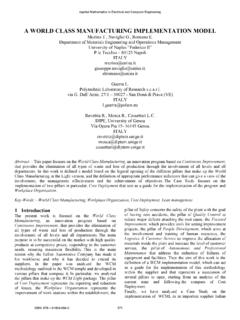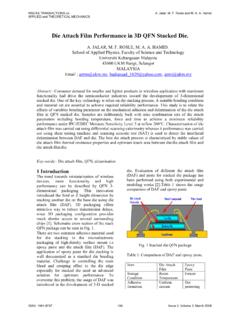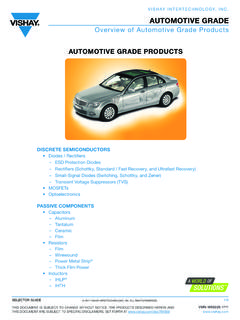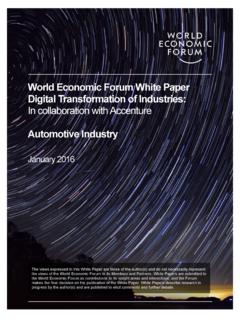Transcription of PROJECT MANAGEMENT ON NEW PRODUCT …
1 PROJECT MANAGEMENT ON NEW PRODUCT development AND LAUNCH IN THE automotive industry Prof. Virgil POPA PhD Prof. Dorina TANASESCU PhD Master student Corina DINCA MANAGEMENT Marketing Department University of Valahia Targoviste 35, Stancu Ion Str., T rgovi)te, D mbovi a ROMANIA Engineer Mihai NICOLAE Dacia Renault ROMANIA Abstract: Successful innovation has become a key driver for revenue growth, competitive margins and, in some cases, even for survival. The ability to bring innovation to the market quickly, efficiently and ahead of competition is becoming increasingly important. An efficient PRODUCT launch requires integration and coordination among multiple functional areas, including PRODUCT design, procurement, planning, manufacturing, sales and marketing. In addition, as organizations increasingly leverage core capabilities of other companies, innovation has to be delivered through virtual networks, working with partners in a collaborative environment in order to bring products and services to the market faster, smarter and cheaper.
2 Consequently, organizations need to integrate itself internally and also externally with suppliers and customers, creating end8 to8 end supply chain processes and capabilities which impose differences on PRODUCT and customer requirements. The innovation as a business model is made up of all decisions that a company makes including six main elements, namely: who, what, when, where, why and how much a company needs to provide its goods & services and receive value for its effort. Some of the changes in business, that have the potential to impact a new PRODUCT development (NPD) include: 1. Increased levels of competition; 2. Rapidly changing market environments; 3. Higher rates of technical obsolescence and; 4. Shorter PRODUCT life cycles. Moreover, the importance of being the first on the market is discussed extensively in various sources.
3 Besides the instinctive idea of being the first, other measurable benefits are possible for those that get on the market sooner with innovative products and services: 1. Increased sales through longer sales cycles; 2. Increased margins; 3. Increased PRODUCT loyalty; 4. More resale opportunities; 5. Greater market responsiveness; 6. A sustained leadership position. By referring to new products launch in the auto industry we see that these trends include time for competition, globalization and strategy, extension of new PRODUCT portfolios and a new MANAGEMENT , outsourcing, cooperation and collaboration, support processes such as informatics systems, modularization and PRODUCT complexity, research and development , production and distribution. Keywords: Innovation, New PRODUCT development (NPD), New PRODUCT Launch, automotive industry , PROJECT MANAGEMENT , Work Breakdown Structure (WBS), Statement of Work (SOW), Microsoft PROJECT , Gantt Chart Proceedings of the 2nd International Conference on Manufacturing Engineering, Quality and Production SystemsISSN: 1792-4693217 ISBN: 978-960-474-220-21 New PRODUCT development & Launch New PRODUCT development New PRODUCT development is one of the most important value8creating processes in every industry .
4 New products create interest, excitement and new business opportunities by providing customers with better, more convenient or lower priced ways to fulfil their needs. Many voices believe that distributors and suppliers working together as allies can both reduce the costs of PRODUCT development and introduction and, more importantly, develop more and better products than those that are being produced today. If the world was stable, there would be no need to change business operation and methods, or to understand what has changed and what works well. However, firms operate in dynamic environments, not stable ones. In response, MANAGEMENT processes must also change over time so that firms can remain effective and profitable through this changing situation. Some of the changes in business with the potential to impact the ways in which new PRODUCT development (NPD) is practiced and managed include: 1.
5 Increased levels of competition; 2. Rapidly changing market environments; 3. Higher rates of technical obsolescence; 4. Shorter PRODUCT life cycles. A primary impact of these environmental changes is to implement changes which help speed products through development , and improve process efficiency and overall NPD effectiveness. The Model of the PRODUCT development and MANAGEMENT Association (PDMA) wants to create and disseminate knowledge about managing and improving new PRODUCT development . Best research practices wish to: 8 determine the current status of PRODUCT development practices and performance; 8 understand how PRODUCT development has changed from five years ago; 8 determine whether differences exist in NPD practice or performance across industry segments; 8 investigate process and PRODUCT development tools which differentiate the success on PRODUCT development .
6 The three parts of the innovation process: fuzzy front end (FFE), new PRODUCT development (NPD), and commercialization. New concept development model PDMA model shown in Fig. 2 consists of three key parts: 8 The engine or bull s8eye portion is the leadership, culture, and business strategy of the organization that drives the five key elements that are controllable by the corporation; 8 The inner spoke area defines the five controllable activity elements (opportunity identification, opportunity analysis, idea generation and enrichment, idea selection, and concept definition) of the FFE; 8 The influencing factors consist of organizational capabilities, the outside world, and the enabling sciences that may be involved. The inner are called elements, as opposed to processes. A process implies a structure that may not be applicable and could force the use of a set of poorly designed controls to manage FFE activities.
7 In addition, the model has a circular shape, to suggest that ideas are expected to flow, circulate, and iterate between and among all five elements. New concept development (NCD) construct is a relationship model, not linear process.[1] Influencing Factors (The Environment) The FFE exists in an environment of influencing factors: the corporation s organizational capabilities, customer and competitor influences, the outside world s influences, and the depth and strength of enabling sciences and technology. Organizational capabilities determine whether and how opportunities are identified and analyzed, how ideas are selected and generated, and how concepts and technologies are developed. Proceedings of the 2nd International Conference on Manufacturing Engineering, Quality and Production SystemsISSN: 1792-4693218 ISBN: 978-960-474-220-2 Sciences and technology become enabling when they can be used repeatedly in a PRODUCT or service.
8 Enabling is not the same as mature . It is the point when the technology is developed enough to build it into a manufactured PRODUCT or a regular service offering. Enabling technologies usually provide some degree of enhanced utility, cost avoidance, value, or quality improvement for the customer. Outside world, government policy, environment regulations, laws concerning patents, and socioeconomic trends, all affect the FFE as well as the new PRODUCT development or Stage8 Gate part of the innovation process. Some of these factors are indicated in Porter s five force model (1987). Porter s model evaluates the relative power of customers, competitors, new entrants, suppliers, and industry rivalry a power relationship that determines the intensity of competition and often inspires innovation. The Engine (Leadership, Culture and Business Strategy) The element of leadership, culture, and business strategy sets the environment for successful innovation.
9 Proficiency in this element distinguishes highly innovative companies from the less innovative ones. The seven factors that set these companies are : 8 Leaders demonstrating in every decision and action that innovation is important for their company; 8 Encouraging purposeful evolution and encouraging employees to try new things; 8 Developing real relationship between marketing and technical people; 8 Generating customer intimacy by encouraging their employees to interact closely with customers; 8 Engaging the whole organization in understanding that innovation is the fundamental way by which company brings value to its customers; 8 Continuing to value the individual and set an environment that is conductive to high motivation; 8 Telling powerful stories that reinforce the principles and practices of innovation.
10 Opportunity Identification Business and technology opportunities are explicitly considered so that resources will be allocated to new areas of market growth, operating effectiveness, and efficiency. For example, the opportunity may be a near8term response to a competitive threat, a breakthrough possibility for capturing competitive advantage, or a means to simplify operations, speed them up, or reduce their cost. It could be an entirely new direction for the business or an upgrade to an existing PRODUCT . It could also be a new PRODUCT platform, a new manufacturing process, a new service offering, or a new marketing or sales approach. Opportunity identification in many cases precedes idea generation and enrichment. It also may enable linking unanticipated notions to business or marketplace needs that were not previously known.

















